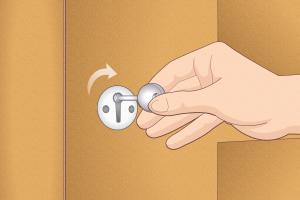Ultimate Guide to Locking a Door: Techniques, Tips, and Best Practices

-
Quick Links:
- Introduction
- Importance of Locking Doors
- Types of Door Locks
- How to Lock a Door: Step-by-Step Guide
- Common Locking Mistakes
- Case Studies
- Expert Insights
- Conclusion
- FAQs
Introduction
Locking a door may seem like a simple task, but it plays a crucial role in ensuring the safety and security of your home or office. Whether you're leaving for a few hours or for an extended vacation, understanding the various methods and techniques for locking a door can greatly enhance your security and peace of mind.
Importance of Locking Doors
According to the FBI, a burglary occurs every 26 seconds in the United States. This statistic underscores the importance of locking your doors to deter potential intruders. A locked door is often the first line of defense against unauthorized entry, protecting your personal belongings and ensuring your safety.
Types of Door Locks
When it comes to locking doors, it's essential to understand the different types of locks available. Each type serves a specific purpose and offers varying levels of security.
Deadbolt Locks
Deadbolt locks provide a higher level of security than standard spring bolt locks. They are typically installed on exterior doors and require a key or a thumb turn to unlock. Deadbolts come in single and double-cylinder varieties.
Knob Locks
Commonly found on interior doors, knob locks are easy to use but offer less security compared to deadbolts. They are often used in conjunction with deadbolts for added security.
Smart Locks
Smart locks offer modern convenience, allowing you to lock and unlock doors using your smartphone or other devices. They often come with additional features like remote access and monitoring.
Padlocks
Padlocks are portable locks that can be used on gates, sheds, and storage units. They are available in a variety of styles and security levels.
How to Lock a Door: Step-by-Step Guide
Locking a door properly is essential for security. Here’s a comprehensive step-by-step guide:
Step 1: Choose the Right Lock
- Assess your security needs.
- Select a high-quality lock that meets those needs.
Step 2: Install the Lock
Follow the manufacturer’s instructions to ensure proper installation. If you're not comfortable, consider hiring a professional locksmith.
Step 3: Locking Mechanism
- For knob locks, turn the knob clockwise until you hear a click.
- For deadbolts, turn the key or thumb turn until it is secure.
- For smart locks, ensure your smartphone app is connected and follow the app's instructions.
Step 4: Test the Lock
After locking, test the door by pulling on it to ensure it is secure. This step is crucial to ensure your door is locked properly.
Step 5: Additional Security Measures
- Consider installing additional security features like door alarms or security cameras.
- Regularly check the condition of your locks and replace them if necessary.
Common Locking Mistakes
Even the most security-conscious individuals can make mistakes when locking doors. Here are some common errors to avoid:
- Not checking the lock after closing the door.
- Using weak or outdated locks.
- Leaving spare keys under mats or in obvious hiding spots.
Case Studies
To understand the impact of proper locking techniques, consider the following case studies:
Case Study 1: Residential Burglary Prevention
A homeowner in a suburban area installed a smart lock and security camera system. After implementing these measures, they reported a 70% decrease in attempted burglaries in their neighborhood.
Case Study 2: Business Security
A small business upgraded their locks to high-security deadbolts and implemented a routine check of all entrances. They experienced no break-ins for over two years.
Expert Insights
We spoke with security expert Jane Doe, who emphasizes the importance of understanding your environment:
“Every home and business has unique vulnerabilities. It’s crucial to assess these factors and choose the right locking mechanisms accordingly.”
Conclusion
Locking a door may seem like a simple task, but it is a vital aspect of home and business security. By understanding the different types of locks, following the proper procedures, and avoiding common mistakes, you can significantly enhance your security measures. Remember to stay informed about the latest locking technologies and practices to keep your property safe.
FAQs
- Q1: How do I know if my door is locked?
A1: Pull on the door handle to ensure it doesn't open. If it stays shut, it is locked. - Q2: What type of lock is best for home security?
A2: Deadbolts are recommended for exterior doors due to their strength. - Q3: Can I rekey my locks myself?
A3: Yes, but it's often best to hire a locksmith for precise rekeying. - Q4: Are smart locks safe?
A4: Yes, when installed and used correctly, they provide enhanced security. - Q5: What should I do if my lock is jammed?
A5: Try lubricating the lock with graphite or contact a locksmith for assistance. - Q6: How often should I change my locks?
A6: It's advisable to change locks every few years or after a security breach. - Q7: What's the difference between single and double-cylinder deadbolts?
A7: Single-cylinder locks use a key from the outside and a thumb turn inside, while double-cylinder locks require a key for both sides. - Q8: Are there locks that automatically lock?
A8: Yes, many smart locks have an auto-lock feature that engages after a set time. - Q9: Can I use a padlock on my front door?
A9: While possible, it’s not recommended as a primary locking mechanism for residential doors. - Q10: How can I improve my door security?
A10: Consider adding a security camera, alarm system, or reinforced door frame.